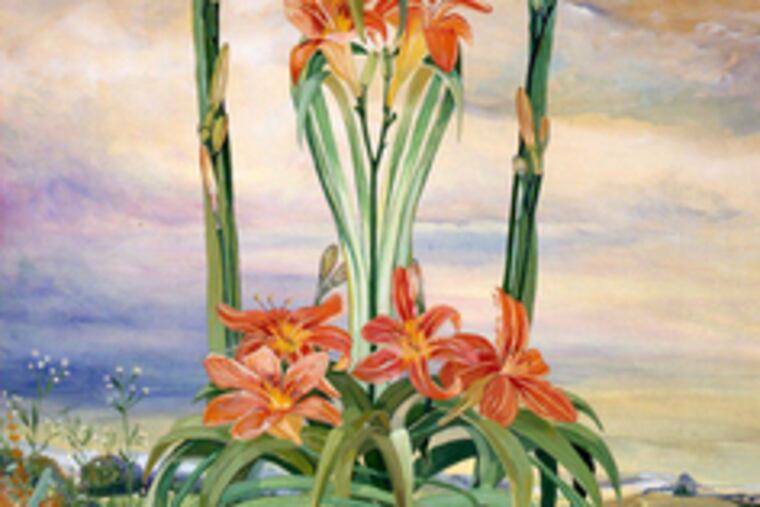Drawing on nature's beauty
Timothy Martin makes objects bloom with floral motifs. See his work at the flower show.

Timothy Martin is sitting in his beautiful light-filled studio in Sergeantsville, N.J., a man with so much to be grateful for, you can't imagine why his eyes are filling with tears.
He's 59, an artist who seems to finally be making it. But this afternoon, as a light snow falls outside, he grows emotional recalling the carefree summers of his youth.
Not far from where we sit, in Ringoes, he's running through the woods of his grandparents' farm again and inhaling that celerylike smell, whatever it was, that infused his grandmother's pantry . . . and drove him crazy, as an adult, until he identified it as lovage. Now, it grows in the garden he and his wife, Janis Burenga, cultivate on their 19th-century farm.
He's remembering his dad, a Navy man, coming home one night with a hunk of walnut and some tools to surprise Timmy, second oldest of seven, a boy who struggled to read but longed to carve.
And he's sharing the names of teachers who encouraged him to draw, paint, sculpt, create. Decades later, when he meets them on the street, they insist they always knew he'd be a real artist some day. A high school French teacher even hung his Eiffel Tower painting in her living room.
"Chokes me up," Martin says. His smile returns.
Visitors to the 2006 Philadelphia Flower Show may recall, with their own smiles, the whimsical paintings he exhibited there: couches made of onions, cabbages, cauliflowers and eggplants; a forsythia chair, and an upholstered wing chair with, what else, birds' wings on either side.
Martin will return to the 2008 flower show March 2 to 9 at the Convention Center, bringing with him about 50 of his quirky flower paintings. The show's theme is "Jazz It Up!" so his motif is musical, too.
Wandering around his studio, you get a taste of what's in store. It's full of canvases of musical instruments, which he's interpreting as expressions of the forms and designs in nature.
"I want people to associate objects with nature, to look at things and bring them back to their organic source," he says.
We see a bass cello with soft magnolia blossoms, large as life, filling the instrument's bulbous outline. There's a honeysuckle harp, all golden ochre; a trombone of jolly zinnias, and a saxophone sexed up with orchids.
"I'm imprinting nature on top of classic form, making people question the origin of that shape," he says.
Martin spent years searching for his true artistic style, something distinctive that would "comfort the viewer" and amuse. The search continued through many personas - art student, teacher and impoverished practitioner, freelance carpenter, home renovator.
Finally, it came to him: Every classic form in culture and society mimics something organic. And there are no straight lines in nature.
He began with furniture, seeing the facets of a fern in wicker chairs. Seeing a camelback couch compelled him to paint a couch with a camel as its back. Cushions became so many snowdrifts.
"I started to see this everywhere," Martin explains. "The idea keeps opening up to me like a flower."
A flower with humor, that is. This is key to Martin's style, though he laments that the serious art establishment may consider what he does neither serious nor art.
"I know what's in the Chelsea galleries," he says, "but there's too much gloom in this day and age. I want people to feel a little lighthearted and uplifted when they see my work.
"Doesn't mean it isn't still a serious piece of work," he grumbles.
He's done exquisite window displays for Tiffany's. And call it what you will, his baby grand pianos are a sight to see.
Steinway & Sons commissioned him to paint limited-edition piano cases with flora from each of the four seasons. "Summertime," which Martin says sells for $160,000, is featured on the company's Web site (www.steinway.com/steinway/artcase_collection/summertime.shtml).
He'll paint a piano lid with spring flowers for the 2008 flower show here. At the moment, it awaits transformation in his studio.
All this piano-painting inspires him to think butterfly piano and orchid piano and waterfall piano and who knows what else? Butterfly piano legs, that's what, and orchid music holders. He's working on the prototypes.
As he works, the lyrical voice of Andrea Bocelli wafts through the studio. "He's my guy," Martin explains as unapologetically as he does his "lighthearted" paintings. This, after all, is the sentimental tenor opera purists disparage, even as the public clamors for more.
After the Philadelphia Flower Show, Martin is booked for similar gigs in Omaha and Atlanta. More good news for an artist whose large oil paintings now sell for $45,000.
And pretty darned good for a Navy brat who spent summers not in art enrichment programs, but on a farm in New Jersey with his old-world Polish grandparents. "A kid's paradise," he calls those days of gathering sweet Seckel pears with grandmother Babci (BOB-shee) and bringing in the hay with grandfather Dziadzi (JOD-gee).
The endearments slip out of his mouth, moving him to tears and laughter once more. His roots in the land, first planted then, still run deep, shaping the talent and sensibility that define him today.
Martin begins each morning with a hike along the Wickecheoke Creek, which meanders through his six-acre farm, accompanied by his Lakeland terriers Daisy and Duffy.
As they amble along, Martin notes, and often photographs, the many wild things they encounter: trout lilies and violets, dandelions and broccoli rabe. "Our spring salad," he says gaily.
He files the images away in a studio drawer that also holds a Burpee seed catalog like the ones that sent Babci's heart soaring, and a battered box of oil paints, a gift from Dad when he was 9.
More Information
To see Timothy Martin's works, go to www.timothymartin.com.EndText
Find gardening blogs, tips, readers' photos, and more at http://go.philly.com/gardening.EndText